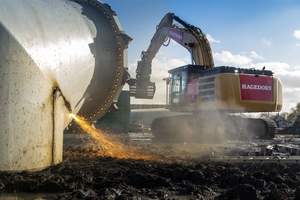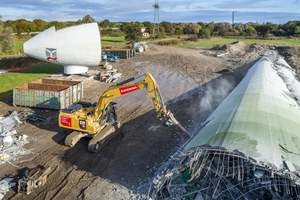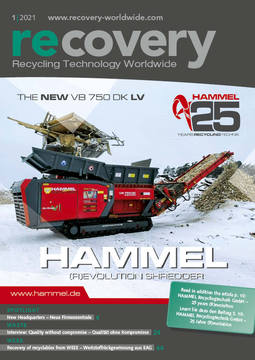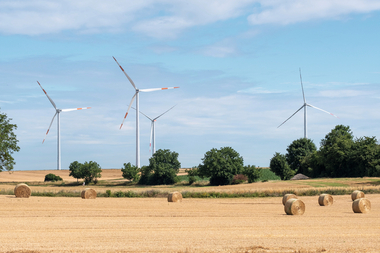Wind turbines deserve green disposal
The German wind energy industry is expecting a wave of dismantling of disused wind turbines. Hagedorn‘s specialists show that demolition and recycling belong together, as exemplified by the Jade Wind Farm in Wilhelmshaven.
The dismantling of decommissioned wind turbines is currently a major issue. At the turn of the year, the 20-year subsidy under the Renewable Energy Sources Act (EEG) ended for around 5200 turbines, with a further 8000 to follow by 2025. In the meantime, there is a political transitional solution for subsidized wind turbines, but sooner or later operators will have to ask themselves the question: continue operating without subsidy, repower or dismantle? Due to economic considerations, many operators will in all likelihood opt for the latter.
For Frank Kreimer, Managing Director of Hagedorn Abbruchservice GmbH and first point of contact for wind turbine dismantling, one thing is certain: „Wind turbines that produce green electricity also deserve environmentally sound and sustainable disposal.“ Already since 2013, the recycling of wind turbines with the maximum degree of recovery has been an established standard at Hagedorn – and now also applies as a guideline for all competitors. This is because Hagedorn, as part of the RDR Wind industry association, developed the new DIN SPEC 4866, which since August 2020 has been considered the guideline for sustainable dismantling of wind turbines.
Sustainable dismantling: a win-win solution for all parties involved
„Recycling a disused wind turbine not only benefits the environment, but can also be very lucrative for the operator,“ emphasizes Frank Kreimer. „For example, the higher the degree of recycling and the possibility of separating the installed material, the better recycling prices can also be achieved.“
With the help of special equipment, Hagedorn employees can identify directly on site which precious metals have been used. Whether aluminum, copper or different stainless steel alloys – everything is sorted accordingly, disposed of professionally or sold. „When using steel, we even achieve a one hundred percent quota,“ says Kreimer. „And especially with gearless turbines, whose rotors and stators contain a lot of copper, good scrap prices can be achieved.“
In addition, large amounts of concrete debris are often generated when wind turbines are dismantled. „For a park with ten concrete tower turbines, that can quickly amount to 30 000 to 35 000 tons,“ explains sales representative Mareike Brinkmeyer. Hagedorn supports plant operators in this area. To this end, it arranges for experts to draw up analyses on the feasibility of reuse. „We want the concrete to be approved for reuse, especially in repowering. To procure natural gravel in the same quantity for the construction of new road surfaces is not justifiable in terms of CO2 emissions,“ Brinkmeyer emphasizes. Countless tractor-trailer trips, the associated diesel consumption, and the resulting tons of CO2 emissions – all this contradicts the sustainability idea of green wind energy, he says. „In addition, using recycled concrete can save up to € 30 000 per wind turbine,“ says the expert.
Hagedorn offers the entire dismantling chain from a single source
How the whole thing works in practice was recently demonstrated by Hagedorn‘s specialists at the Jade Wind Farm in Wilhelmshaven. Older Enercon turbines had to be dismantled there. First, the nacelles and rotor blades of the cast-in-place concrete towers were dismantled. Then the blasting experts set to work. „Blasting has to be carried out from a tower height of 85 m, as the maximum working height of a cable excavator is then reached,“ explains Mareike Brinkmeyer. „We then processed the tower and foundation concrete into recycled crushed stone while still on site.“ Using a mobile crushing plant, Hagedorn employees freed the concrete from reinforcing steel, breaking it down to the desired grain size.
„Recycling rotor blades, on the other hand, is much more complex. Often, the composite materials used in them simply end up in waste incineration,“ says Frank Kreimer. How carbon and glass fiber reinforced plastics (CFRP & GFRP) can be disposed of in an environmentally friendly manner, on the other hand, is demonstrated by the Lüneburg-based company neowa GmbH, a reliable partner of Hagedorn. The rotor blades are cut into container-sized pieces while still at the construction site. The carbon and GRP components are then separated at the final processing facility in Bremen. The former are sent for recycling; the latter are further processed in a cement plant. There, they partly provide energy for the production process and partly replace coal and sand in cement production. At this point, too, the recycling rate is therefore 100 %.






